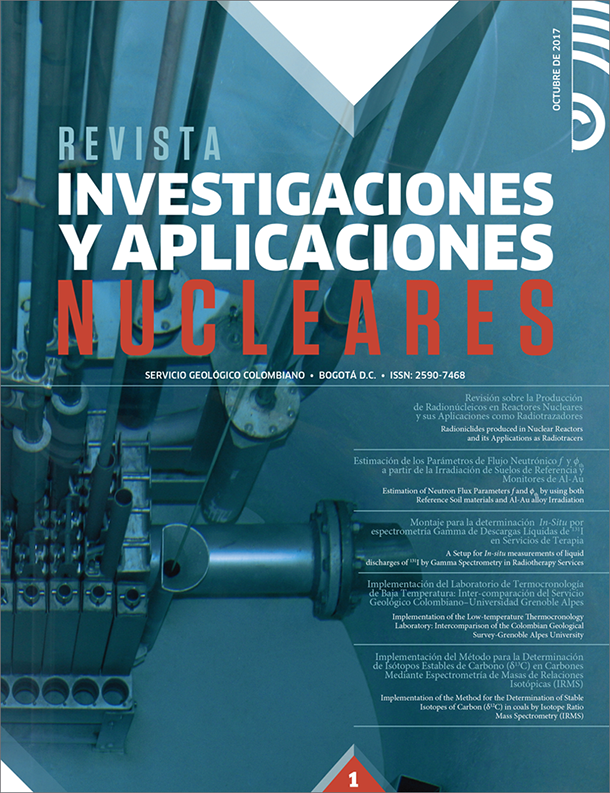Implementation of the Method for the Determination of Stable Isotopes of Carbon (δ13C) in Coals by Isotope Ratio Mass Spectrometry (IRMS)
DOI:
https://doi.org/10.32685/2590-7468/invapnuclear.1.2017.21Keywords:
Isotope Ratio Mass Spectrometry (IRMS), Stable Isotopes, Isotopic RelationDownloads
How to Cite
Issue
Section
Published
Abstract
This paper describes the procedure for determining the isotopic ratio of carbon (13C/12C) expressed in delta (δ13C) in the range -46.6 ‰ to +37.63‰ by system composed of an elemental analyzer coupled to a mass spectrometer of isotope ratios (EA-IRMS) in the stable solid isotopes laboratory at the Servicio Geológico Colombiano. The reference materials used in the analysis were IAEA-LSVEC, USGS-43, NBS-19 and USGS-41. The results allow us to conclude that the EA-IRMS is suitable for determination of δ13C in coals as a matrix, in the range evaluated; in a reliable and comparable with any other other laboratories thanks to the acceptance criteria and the statistical analysis performed.
References
-[1] K. C. Misra, Introduction to Geochemistry Principles and Applications, Tennessee, USA: Wiley-Blackwell, 2012.
-[2] R. R. Ortega, «Fundamentos teóricos y técnicos de los isótopos estables,» de Técnicas y aplicaciones multidisciplinares de los isótopos ambientales, Madrid, España, UAM Ediciones, Servicio de Publicaciones de la Universidad Autónoma de Madrid, 2008, pp. 1-16.
-[3] U. A. C. Laboratory, «Center for Applied Isotope Studies Stable Isotope Ecology Laboratory,» University of Georgia. Julio 1997. [En línea]. Available: http://sisbl.uga.edu/ratio.html#intro. [Último acceso: 22 de marzo 2017].
-[4] L. S. Santiago et al., « El uso de isótopos estables en biología tropical», Interciencia, 9, vol. 30, 2005. [En línea]. Available: http://www.scielo.org.ve/scielo.php?script=sci_arttext&pid=S0378-18442005000900006. [Último acceso: 22 de marzo 2017].
-[5] M. Baskaran, Handbook of Environmental Isotope Geochemistry, Detroit: Springer, 2011.
-[6] E. Zaidín, «Los isótopos estables y la espectrometría de masas de isótopos,» [En línea]. Available: http://www2.eez.csic.es/files/Los%20Isótopos%20 Estables.pdf. [Último acceso: 22 de marzo 2017].
-[7] Z. Muccio y G. Jackson, «Royal Society of Chemistry,» 14 de noviembre 2008. [En línea]. Available: http://pubs.rsc.org/en/content/articlelanding/2009/an/b808232d#!divAbstract. [Último acceso: 22 de marzo 2017].
-[8] Eurolab España. P.P. Morillas y colaboradores, «Guía Eurachem: La adecuación al uso de los métodos analíticos - Una Guía de laboratorio para la validación de métodos y temas relacionados,» 2016. [En línea]. Available: https://www.eurachem.org/images/stories/Guides/pdf/MV_guide_2nd_ed_ES.pdf. [Último acceso: 22 de marzo 2017].
-[9] M. J. C. Miller James N, Estadística y quimiometría para química analítica, Madrid: Prentice Hall, 2002.
-[10] Centro español de metrología y JCGM, «Vocabulario Internacional de Metrología. Conceptos fundamentales y generales, y términos asociados» 2012. [En línea]. Available: http://www.cem.es/sites/default/files/vim-cem-2012web.pdf. [Último acceso: 16 de marzo 2015].
-[11] R. Guerrero y M. Berlanga, «Isótopos estables: Fundamento y aplicaciones», Actualidad de la Sociedad Española de Microbiología, vol. 30, p. 17- 23, 2000.







